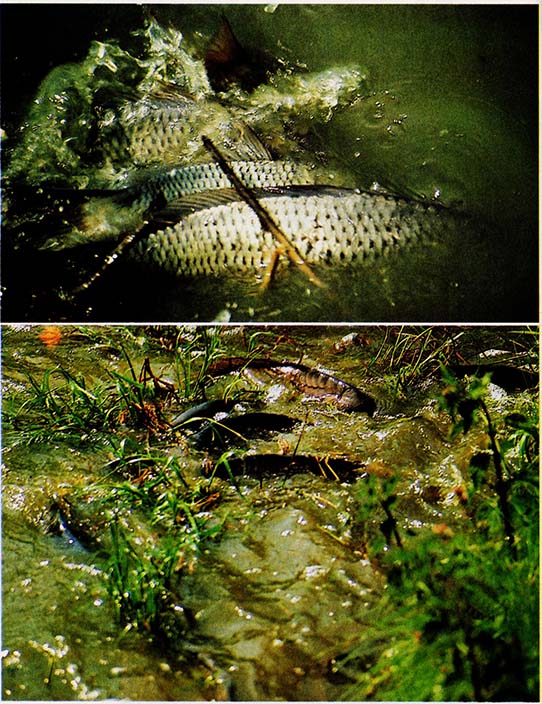 W naszych warunkach klimatycznych karpie trą się bardzo rzadko. W większości wód karpie pochodzą z zarybień. Niezręczny na pierwszy rzut oka karp jest bardzo energicznym, a zarazem delikatnym kochankiem. Hodowcy wiedzą o tym i przygotowują karpiom przytulne miłosne gniazdka.
W naszych warunkach klimatycznych karpie trą się bardzo rzadko. W większości wód karpie pochodzą z zarybień. Niezręczny na pierwszy rzut oka karp jest bardzo energicznym, a zarazem delikatnym kochankiem. Hodowcy wiedzą o tym i przygotowują karpiom przytulne miłosne gniazdka.
Karpie są ulubionymi rybami wielu wędkarzy. Złowienie dużego karpia jest prawdziwym wyzwaniem dla specjalistów: karpie jeszcze częściej biorą także zwykłym wędkarzom łowiącym ryby spokojnego żeru. Ryby te mają także bardzo smaczne mięso – karp z czystej wody jest prawdziwym delikatesem i niektórzy smakosze przedkładają mięso karpia nawet nad mięso pstrąga.
Wielu wędkarzy być może nie zdaje sobie jednak sprawy, że ta niezwykle popularna u nas ryba ma olbrzymie trudności z naturalnym rozmnażaniem się i z tego właśnie powodu większość łowisk musi być sukcesywnie zarybiana karpiami.
Tak, to prawdziwa ciekawostka! Jaka jest tego przyczyna? Aby dokładniej zrozumieć istotę „problemów karpi” niezbędne jest chociażby pobieżne przestudiowanie historii hodowli, biologii oraz wymagań życiowych tych ryb.
Już Rzymianie hodowali karpie
Karpie wywodzą się z rzek uchodzących do mórz Kaspijskiego i Czarnego. Stamtąd rozprzestrzeniły się w Dunaju oraz w południowo-wschodniej Azji. Pierwszymi hodowcami karpi w Europie byli Rzymianie. Przetrzymywali je w stawach i rozprzestrzenili ten gatunek w całej Azji Mniejszej, Grecji oraz na Półwyspie Apenińskim. W tamtych czasach mięso karpi uchodziło za prawdziwy rarytas. W końcu Rzymianie sprowadzili je także do Europy Środkowej. Dzięki wam, o Rzymianie, że oprócz wspaniałych win pozostawiliście w spadku po sobie także te cudowne ryby.
Karol Wielki (768 – 814) rozkazał, aby we wszystkich stawach podległych mu dóbr hodowano karpie. Jako pierwsze w Europie Środkowej hodowlą karpi zajęły się klasztory. W okresie postów mnichom nie wolno było jeść mięsa, ale ryby tak. Dlatego też robili wszystko, aby hodowane przez nich karpie były jak najdorodniejsze. Ze względu na to, że klasztory znajdowały się w całej Europie, karpie szybko rozprzestrzeniły się po całym naszym kontynencie. Ryby te są bardzo popularne, tak samo w Izraelu, jak i we wschodniej i południowo-wschodniej Azji.
Karpiami nie interesują się chyba tylko wędkarze w Ameryce Północnej. Mało tego, uważają je nawet za szkodniki. Amerykanie obawiają się, że w przyszłości karpie mogą wyprzeć ich rodzime, delikatniejsze gatunki ryb.
Ciepłolubność
Karpie żyją w Europie Środkowej prawie już od 2000 lat, ale ciągle nie mogą się na dobre zadomowić. Tylko w nielicznych naturalnych zbiornikach wodnych znajdują dogodne warunki do odbycia tarta. Jeżeli nawet uda im się raz na jakiś czas odbyć gody, to i tak w większości rzek i jezior ich potomstwu nie udaje się przeżyć ^pierwszej zimy. Karpie wywodzą się z ciepłych stref klimatycznych. I chociaż żyją i są hodowane u nas od tak dawna, ciągle preferują podwyższoną temperaturę wody. Nauczeni latami doświadczeń hodowcy doskonale o tym wiedzą i uwzględniają te wymagania. Przyjrzyjmy się jak się starają, a być może zrozumiemy, dlaczego w naszych szerokościach geograficznych karpiom tak rzadko udaje się w naturalny sposób skutecznie rozmnożyć. Karpiowe gospodarstwa stawowe mogą więc być tworzone tylko w korzystnych strefach klimatycznych. Na północ od 60 stopnia szerokości geograficznej północnej (Oslo) oraz powyżej 400 m n.p.m. karpiom jest już za zimno. W dogodnych warunkach klimatycznych karpie po trzech latach osiągają masę średnio 1,5 kg. Nawet wtedy trzeba się bardzo postarać, aby ryby te przystąpiły do tarła.
Termin tarła powinien przypadać możliwie jak najwcześniej. Najkorzystniejsza jest druga połowa maja, gdyż tylko wtedy małe karpie mają czas na osiągnięcie rozmiarów pozwalających im przetrwać zimę. Do jesieni wszystkie ryby muszą mieć przynajmniej ok. 10 gramów. W przeciwnym razie mają zbyt małe zapasy energetyczne, aby przetrwać bez pożywienia długą i mroźną zimę. Zbyt wczesne tarło też jest niebezpieczne. Narybek karpia nie przeżywa drastycznych skoków temperatury, jakie występują chociażby na „Trzech ogrodników” w połowie maja.
Hałaśliwa gra miłosna
Aby karpie mogły wytrzeć się w dogodnym terminie, hodowcy przygotowują specjalnie stawy-tarliska, prawdziwe miłosne gniazdka. Stawy te mają powierzchnię od 100 do 200 metrów kwadratowych i są bardzo płytkie. Nazywa się je też stawami Dubisza. Ich nazwa pochodzi od nazwiska znanego hodowcy Tomasza Dubisza, który je wymyślił. Stawy-tarliska są porośnięte miękką trawą i zalewa się je na krótko przed terminem tarła. Powinny być one usytuowane w dobrze nasłonecznionym i osłoniętym od wiatru miejscu, aby woda mogła się w nich jak najszybciej nagrzać.
W momencie, gdy woda ogrzeje się do temperatury 18-20 stopni, natomiast w nocy nie schładza się poniżej 15 stopni, do stawu wpuszcza się pary tarłowe. Przy odrobinie szczęścia już na drugi dzień można nawet z daleka usłyszeć głośną grę miłosną ryb. Głośne chlapanie się karpi w trakcie tarła nazywane jest przez hodowców „uderzeniami”.
Po kilku dniach wykluwają się małe karpie. Przez jakiś czas żyją z zapasów w woreczku żółtkowym, potem potrzebują już właściwego, pełnowartościowego pokarmu naturalnego (mikroskopijny plankton zwierzęcy). Małe karpie rosną bardzo szybko i już po 5 tygodniach ważą około 1 grama, a na początku zimy mają po 50 gramów. Jedynie wtedy mają szansę, że zdrowo doczekają następnego lata.
W naszych wodach otwartych ciepłolubne karpie rzadko znajdują odpowiednie warunki do odbycia naturalnego tarła. W wielu akwenach ze względu na niskie temperatury wody produkty płciowe karpi dojrzewają zbyt późno, czasami dopiero w sierpniu.
Ryby zaczynają szukać gotowych do odbycia tarła partnerów oraz korzystnego miejsca na tarlisko. Kiedy wszystkie te warunki zostają spełnione, przysadka mózgowa karpia zaczyna wydzielać hormon sterujący składaniem ikry i wydzielaniem mleczu. Jeżeli jednak ikra złożona jest zbyt późno, narybek karpi przed nastaniem zimy jest zbyt mały i nigdy nie dożywa wiosny.
Cóż to za szczęście dla nas wędkarzy, że liczne gospodarstwa stawowe rok rocznie dysponują sporym zapasem materiału zarybieniowego. Narybek karpi jest bardzo tani. Najtańsze zarybianie polega na wpuszczaniu do zbiorników wodnych jednorocznych karpi.